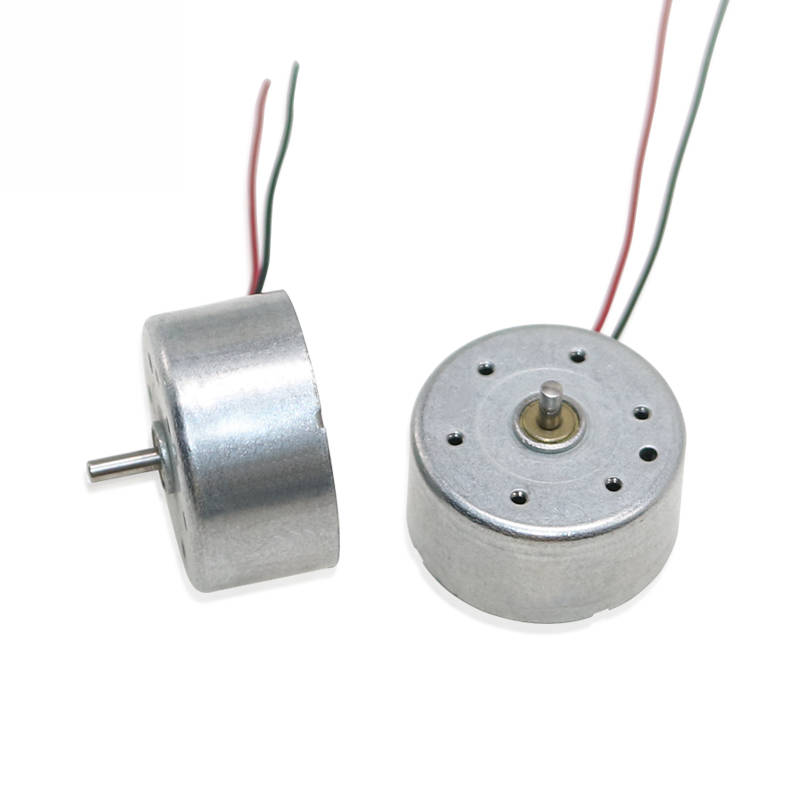5 Key Factors to Choose the Best 5V DC Motor

Choosing the right 5V DC motor is very important. Why? Every part, like torque and control, affects how it works. Think of a tool that measures force to help injuries heal. If it’s not accurate, it won’t work well. Also, research shows uneven voltage lowers motor torque a lot. This is why knowing these details matters. When the motor fits your project’s needs, it works better. Good choices lead to smoother work and better success.
Key Takeaways
Know the voltage your 5V DC motor needs. Match it with your power source to avoid problems.
Learn how speed and torque work together. Pick the right balance for your project to work well.
Think about the motor's size. Choose one that fits your space and gives enough power.
Use gear motors for stronger or more accurate tasks. They improve performance by changing speed and force.
Take care of your motor often. Oil the parts and check wires to make it last longer and work better.
Voltage, Speed, and Torque
Voltage Requirements
When choosing a 5V DC motor, you need to check its voltage requirements. Not all motors work well with the same power source. Some need a steady 5V supply, while others might tolerate slight variations. If the voltage drops too much, the motor’s performance suffers. It can lose torque or even stop working. To avoid this, make sure your power source matches the motor’s needs.
Here’s a tip: Look at the motor’s datasheet. It usually lists the operating voltage range. If your project involves batteries, check how their voltage changes over time. This ensures your motor stays reliable.
Speed and RPM
Speed is another key factor. Every motor has a specific rotational speed, measured in RPM (revolutions per minute). Think about how fast your motor needs to spin for your project. For example, if you’re building a fan, higher RPMs might be better. But for a robotic arm, slower speeds might give you more control.
Keep in mind that speed and torque are connected. When the motor spins faster, it often produces less torque. This means you’ll need to balance speed and torque based on your project’s requirements.
Torque Calculations
Torque is the force that helps your motor turn. It’s especially important when your motor has to move a heavy load. To calculate torque, you’ll need to know the weight of the load and the distance from the motor’s axis. This helps you figure out if the motor can handle the job.
For example, if your project involves lifting objects, you’ll need to check the motor’s rated torque. This tells you the maximum force it can produce. If your load is too heavy, the motor might stall or wear out quickly.
Pro tip: Test your motor under real conditions. Measure its on-load torque to see how it performs when it’s actually working. This gives you a better idea of whether it’s the right fit for your project.
Motor Size and Performance
Size Limits
For small projects, motor size is very important. Limited space can make fitting a big motor hard. That’s why you should think about size early. Smaller motors work well in tight spaces but must still provide enough power.
Remember, the motor driver also needs space. Some drivers are tiny and fit easily, while others are bigger to handle heat. If space is tight, pick a small driver that meets your power needs.
For instance, if building a small robot, choose a motor that fits the frame. Measure the space you have and compare it to the motor’s size before deciding.
Performance Choices
Picking the right motor size means making some trade-offs. Small motors save space but may lack strong torque. Bigger motors give more torque but need more room. So, how do you decide?
Think about what your project needs most. For lifting heavy things, choose a bigger motor with more torque. If speed or accuracy matters more, a smaller motor might work better.
Also, consider heat. Small motors can overheat if overworked, which lowers performance. Bigger motors handle heat better but might need cooling systems.
Tip: Test your motor in real conditions. This shows how size and performance trade-offs affect your project. Find the balance where your motor gives the right mix of power, speed, and reliability.
Benefits of Gear Motors
What Are Gear Motors?
A gear motor is a motor with gears to improve how it works. The gears change the motor’s speed and force to fit your project. This makes them great for jobs needing accuracy or extra strength.
Think of a gear motor as a helper. The motor gives power, and the gears adjust it for the task. For example, if you need slow but strong movement, the gears lower speed and add force. If speed is more important, the gears make the motor spin faster.
Tip: Check the gear ratio when picking a gear motor. It shows how much the gears change the motor’s output. A higher ratio means more force but slower speed.
Advantages of Gear Motors
Gear motors give more force than regular motors. This makes them great for heavy tasks like lifting or pulling. If your project needs to move something heavy, gear motors can handle it easily.
Here’s why gear motors are special:
Efficiency: They save energy and work better.
Compact Design: The motor and gears together take up less space.
Durability: Gears protect the motor, making it last longer.
Versatility: Use them in robots, conveyor belts, or electric cars.
Imagine making a robotic arm. Without a gear motor, it might not lift things well. But with one, the arm gets stronger and moves smoothly.
Note: Take care of gear motors to keep them working well. Oil the gears and check for damage to make them last longer.
Duty Cycle Considerations
Understanding Duty Cycle
Have you thought about how long a motor can run? The duty cycle explains this. It’s the time a motor works compared to its rest time. This is shown as a percentage. For example, if a motor runs 30 seconds and rests 30 seconds, the duty cycle is 50%.
Knowing this is important because motors have limits. If you overuse a motor, it can overheat or wear out faster. You can find the duty cycle in the motor’s specs. Check it carefully to avoid damaging the motor.
Tip: Unsure about the duty cycle? Test the motor in real use. This shows how it performs over time.
Matching Duty Cycle to Project Needs
Different projects need different duty cycles. Some motors run all the time, like in fans. Others, like robotic arms, work in short bursts. Picking the right duty cycle helps the motor last longer and work better.
First, figure out how often your motor will run. If it needs to run nonstop, choose one with a 100% duty cycle. For tasks with breaks, a lower duty cycle is fine. Don’t forget to think about cooling time. This keeps the motor from overheating and improves its life.
Pro Tip: Use a motor controller to manage the duty cycle. It helps prevent overheating and keeps the motor running smoothly.
Practical Implementation Tips
Wiring and Connections
Correct wiring is key for your motor to work well. Bad connections can cause problems or damage the motor driver. Use wires that match your motor’s current needs. Thicker wires carry more current safely and prevent overheating.
Always check the polarity when connecting the motor driver. Wrong connections can harm the motor system. Use a multimeter to check voltage before turning it on. If you use PWM signals for speed control, secure all connections tightly. Loose wires can mess up signals and lower motor performance.
Tip: Label your wires during setup. This helps fix issues faster later.
Testing and Calibration
Testing makes sure your motor works as it should. Calibration helps adjust it for your project needs. Start by running the motor with a normal load. Check its speed, torque, and current to see if it meets your goals.
For accurate calibration, use tools like Zes Zimmer analyzers or Danisense sensors. These tools measure DC power precisely. For example, the LMG600 series measures currents from 500 μA to 32 Arms. Danisense transducers are very accurate, down to 1 ppm, for calibration tests.
Pro Tip: Use a PWM signal generator to test your motor driver. This helps you easily adjust speed and torque during calibration.
Maintenance and Longevity
Regular care keeps your motor working well and lasting longer. Lubricate moving parts as recommended to reduce friction and wear. Check the motor driver for overheating or damage. Replace worn parts quickly to avoid bigger problems.
A micro DC motor can last thousands of hours if maintained well. Keep the motor system clean and dust-free. Check connections often to make sure they stay tight.
Note: Make a maintenance schedule for your project. This helps keep your motor in good shape and ensures long-term success.
Picking the right 5V DC motor means knowing five main things: voltage, speed, torque, size, and duty cycle. These factors help your motor work well and last longer. If you understand how torque helps with heavy loads or how control improves accuracy, your project will run better.
Use this knowledge in your projects. Whether making a robot or a fan, matching the motor’s features to your needs is key. A good 5V DC motor doesn’t just work—it performs great in your setup.
Tip: Test and care for your motor often. This keeps it dependable and working smoothly.
FAQ
What is the difference between a brushed and brushless 5V DC motor?
Brushed motors use brushes to pass electricity, while brushless motors use electronics. Brushless motors are quieter and last longer. Brushed motors are simpler and cost less.
Tip: Choose brushless motors for better durability and efficiency.
Can I use a 5V DC motor for high-torque applications?
Yes, but check the motor’s torque rating first. For more torque, use a gear motor. Gears boost torque by lowering speed, making them great for heavy tasks.
Pro Tip: Always calculate your project’s torque needs before picking a motor.
How do I control the speed of a 5V DC motor?
Use a PWM (Pulse Width Modulation) controller. It changes speed by adjusting voltage pulses. Many motor drivers support PWM, so it’s easy to use.
Note: Check voltage with a multimeter during setup to avoid issues.
What happens if I exceed the motor’s duty cycle?
Going over the duty cycle can overheat the motor and shorten its life. Motors need breaks to cool down. Match the duty cycle to your project to prevent damage.
Reminder: Look at the motor’s datasheet for its duty cycle limits.
How do I maintain my 5V DC motor?
Clean it, oil moving parts, and check for damage often. Tighten loose wires and replace broken parts quickly. Good care helps your motor last longer and work better.
Emoji Tip: 🛠️ Plan regular checks to keep your motor running smoothly!
See Also
Five Essential Steps for Choosing a Small Vibrator Motor
How to Choose the Perfect 3 Volt DC Motor
Utilizing 3V DC Motors Across Five Different Devices
Get Custom Micro DC Motors from
INEED Motors!
Leading Brand in Vibration Motor Manufacturing Industry
